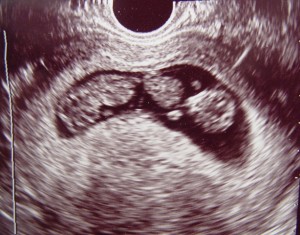About 40% of twins present as cephalic/cephalic.
The remainder pose some abnormal presentation of one or both twins. Because of the abnormal presentations and the complexities of delivering twins, many are delivered by cesarean section.
Some physicians favor cesarean delivery for all twins feeling that this is probably a little safer for the babies and not appreciably more dangerous for the mother. Others offer vaginal delivery on a selective basis. Factors that can contribute a greater degree of safety to vaginal delivery of twins include:1st Trimester Twins on ultrasound
- Experience of the operator
- Cephalic/cephalic presentation
- Previous vaginal deliveries of the mother
- Not too big and not too small
- No large discrepancy in twin sizes.
- Normal electronic fetal monitoring pattern
- Normal progress in labor
- Resources for quickly changing to a cesarean section for one or both twins in the event of unfavorable occurrences.
One special circumstance requiring a cesarean section is a mono-amniotic sac with breech/cephalic twins. In this case, the opportunity of “interlocking twins” during delivery is too great and cesarean section is normally chosen.
If vaginal delivery is chosen, remember that following delivery of the first twin, there is a period of time during which contractions slow or stop. Both placentas remain inside the uterus and attached.
It is usually safest to make no attempt to speed up this process, but to await the resumption of contractions. This could take a few minutes or many minutes. While waiting, monitor the second twin’s heart beat and if normal, continue to observe the patient.
If contractions do not promptly resume, it is acceptable to stimulate the uterus with oxytocin.
With your hand in the vagina, feel the fetal presenting part. If it is not engaged, try to guide it down to the pelvic inlet. Avoid rupturing membranes until the fetal presenting part is engaged in the birth canal.
As the presenting part descends, ask the mother to bear down and usually the second twin will deliver as easily as the first twin.
Among populations without access to routine ultrasound scanning during pregnancy, about one out of four twins remain undiagnosed until after delivery of the first twin. In operational settings, whenever there is doubt about this situation and ultrasound is unavailable, a single AP x-ray of the maternal abdomen will usually provide the obstetrical provider with the knowledge of presentation needed for safe delivery.
With higher order multiples (triplets and above), Cesarean section is usually selected, to minimize the risk of placental abruption causing problems following the delivery of the first and second baby.

